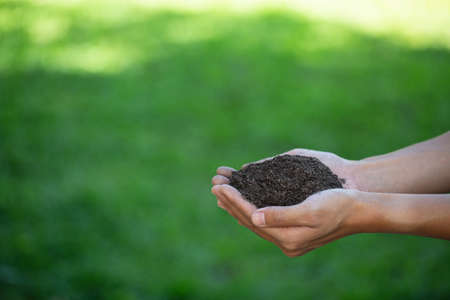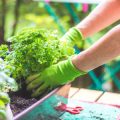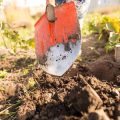1. Understanding Soil Health
Healthy soil is the backbone of any successful organic garden. Its more than just dirt—its a living, breathing ecosystem that supports plant growth, retains water, and cycles nutrients. To grow thriving fruits, vegetables, and herbs organically, its essential to understand the key components that make up healthy soil.
Soil Structure
Soil structure refers to how soil particles (sand, silt, and clay) are arranged. Good soil has a crumbly texture that allows air and water to move freely while holding enough moisture for plants. Loamy soil, which is a balanced mix of sand, silt, and clay, is ideal for most gardens because it provides the right balance of drainage and nutrient retention.
Soil pH
The pH level measures how acidic or alkaline your soil is. Most plants grow best in slightly acidic to neutral soil (pH 6.0–7.0). If the pH is too high or too low, plants cant absorb nutrients effectively—even if those nutrients are present in the soil.
| pH Level | Soil Condition | Effect on Plants |
|---|---|---|
| Below 6.0 | Too acidic | Nutrient lockout; stunted growth |
| 6.0–7.0 | Optimal range | Best nutrient availability |
| Above 7.0 | Too alkaline | Poor absorption of iron and phosphorus |
Microorganisms in Soil
Healthy soil is alive with billions of microorganisms like bacteria, fungi, protozoa, and nematodes. These tiny creatures help break down organic matter into nutrients that plants can use. They also improve soil structure and protect roots from harmful pests and diseases.
Common Beneficial Microorganisms:
- Bacteria: Decompose organic matter and fix nitrogen from the air.
- Fungi: Form partnerships with plant roots (mycorrhizae) to help absorb water and nutrients.
- Nematodes: Some feed on harmful pests; others help cycle nutrients.
Nutrient Content
A fertile soil contains essential macronutrients like nitrogen (N), phosphorus (P), and potassium (K), as well as micronutrients such as calcium, magnesium, sulfur, zinc, and iron. Regularly testing your soil helps you understand what’s lacking so you can amend it appropriately using compost or organic fertilizers.
| Nutrient | Role in Plant Growth |
|---|---|
| Nitrogen (N) | Promotes leafy growth |
| Phosphorus (P) | Aids root development and flowering |
| Potassium (K) | Improves overall plant health and disease resistance |
The Importance of Maintaining Soil Vitality
Caring for your soil means caring for your entire garden ecosystem. Healthy soil holds moisture better during dry periods, drains well during heavy rains, resists erosion, and reduces the need for chemical inputs. When we invest in building living soil through composting and other organic practices, we create a self-sustaining environment where plants thrive naturally.
Quick Tips for Improving Soil Health:
- Add compost regularly to enrich organic matter.
- Avoid tilling too much—it disrupts microbial life.
- Use cover crops to prevent erosion and replenish nutrients.
- Test your soil every couple of years to monitor pH and nutrient levels.
Understanding these building blocks of soil health sets the stage for creating a vibrant organic garden full of flavor, color, and nutrition—all while supporting long-term sustainability.
2. The Role of Organic Matter
Organic matter is one of the most important building blocks of healthy soil. Whether youre growing vegetables, flowers, or fruit trees, adding organic materials like leaves, manure, and cover crops can make a huge difference in how your plants grow. These natural ingredients help improve soil texture, retain water more effectively, and support beneficial microbes that keep your garden thriving.
Why Organic Matter Matters
Soil isnt just dirt—its a living system. When you add organic matter to your soil, youre feeding an entire underground community of organisms that work together to support plant health. Heres how different types of organic matter help:
| Type of Organic Matter | Main Benefits |
|---|---|
| Fallen Leaves | Add structure to soil, improve aeration, and slowly release nutrients as they break down |
| Composted Manure (from cows, horses, chickens) | Rich in nutrients like nitrogen; boosts microbial activity and helps with water retention |
| Cover Crops (like clover or rye) | Prevent erosion, add nitrogen when turned into the soil, and increase organic content over time |
Improving Soil Texture
If your soil feels hard and clumpy or too sandy and loose, adding organic matter can help balance it out. Compost and decomposed leaves make clay soils more crumbly and workable, while helping sandy soils hold onto moisture and nutrients better.
Boosting Water Retention
A healthy garden needs consistent moisture—but not too much. Organic matter acts like a sponge in your soil. It absorbs rainwater or irrigation and holds onto it so plant roots can drink when they need to. This reduces the need for frequent watering and helps plants survive dry spells.
Feeding Microbial Life
Bacteria, fungi, earthworms, and other microscopic life forms are essential for breaking down nutrients so plants can absorb them. Organic matter gives these tiny helpers the food they need to stay active and do their job well. In turn, this creates a cycle where your soil becomes naturally richer over time without needing synthetic fertilizers.
Quick Tips for Adding Organic Matter:
- Use compost regularly: Apply 1–2 inches on top of your soil each season.
- Shred leaves before adding: They’ll decompose faster and mix better with the soil.
- Avoid fresh manure: Let it compost first to prevent burning plant roots.
- Plant cover crops in fall: Then till them into the soil in spring for added nutrients.
By understanding the role of organic matter and using it wisely, you’re setting up your garden for long-term success. Healthy soil grows healthy plants—and that all starts with what you put into it.

3. Composting Basics
Composting is one of the easiest and most effective ways to improve soil health in an organic garden. It helps recycle kitchen scraps and yard waste into nutrient-rich humus that supports plant growth naturally. Whether you’re a beginner or looking to fine-tune your composting setup, understanding the basics will help you build and maintain a productive compost pile year-round.
What to Compost
A successful compost pile needs a balance of two main types of materials: “greens” and “browns.” Greens are rich in nitrogen, while browns provide carbon. Mixing both types helps microbes break down the materials efficiently.
Common Compost Materials
| Greens (Nitrogen-rich) | Browns (Carbon-rich) |
|---|---|
| Fruit and vegetable scraps | Dried leaves |
| Coffee grounds | Shredded newspaper |
| Grass clippings | Sawdust (untreated wood) |
| Tea bags (without plastic) | Straw or hay |
Avoid adding meat, dairy, oily foods, or pet waste, as they can attract pests and cause unpleasant odors.
The Carbon-to-Nitrogen Ratio
The ideal carbon-to-nitrogen (C:N) ratio for composting is about 30:1. This means for every part of green material, you’ll want roughly 2–3 parts of brown material. Too much nitrogen can make your pile smelly and soggy, while too much carbon can slow down the decomposition process.
Tips for Balancing Your Pile
- If the pile smells bad, add more browns like dry leaves or shredded paper.
- If decomposition is slow, mix in more greens like grass clippings or food scraps.
Maintaining a Healthy Compost Pile Through the Seasons
Your compost pile needs air, moisture, and occasional turning to keep it working properly. Here’s how to care for it throughout the year:
Seasonal Composting Tips
| Season | Care Tips |
|---|---|
| Spring | Add fresh greens from lawn trimmings; turn pile regularly to speed up activity. |
| Summer | Keep pile moist but not soggy; water occasionally if it dries out. |
| Fall | Add plenty of browns like fallen leaves; shred them for faster breakdown. |
| Winter | Pile may slow down; insulate with straw or cover to retain heat. |
With just a little attention and effort, your compost will break down into dark, crumbly material that improves soil texture, feeds beneficial microbes, and enhances plant health—all essential elements of successful organic gardening.
4. Using Compost in the Garden
Compost is one of the best tools organic gardeners have for improving soil health. Its full of beneficial microbes and nutrients that help plants grow strong and healthy. Knowing how and when to apply compost can make a big difference in your gardens success.
Topdressing with Compost
Topdressing means spreading a thin layer of compost over the surface of your garden beds. This method feeds the soil slowly over time, encourages earthworms, and helps retain moisture. It’s especially helpful for perennial beds or around established plants where digging isn’t ideal.
How to Topdress:
- Apply 1/2 to 1 inch of compost on top of the soil.
- Avoid piling compost against stems or trunks of plants.
- Water lightly after applying to help compost settle in.
Amending Soil Before Planting
Before planting vegetables or flowers, mixing compost into your garden beds gives your plants a strong start. This improves soil texture, boosts nutrient content, and supports microbial life.
When and How to Amend Soil:
| Timing | Steps |
|---|---|
| Early spring or fall (before planting) |
|
Making and Using Compost Tea
Compost tea is a liquid made by steeping compost in water. It’s used as a nutrient-rich watering solution or foliar spray to boost plant health and improve soil biology.
Simple Compost Tea Recipe:
- Add about 1 part finished compost to 5 parts water in a bucket.
- Stir well and let it sit for 24–48 hours, stirring occasionally.
- Strain the liquid through cheesecloth or an old t-shirt.
- Use immediately to water plants at the base or spray on leaves.
Tips for Best Results:
- Avoid using chlorinated water; rainwater or dechlorinated tap water is best.
- Apply early in the day to allow foliage to dry if spraying leaves.
- Use within a few hours after brewing for maximum benefit.
Incorporating compost into your gardening routine—whether by topdressing, amending soil before planting, or making compost tea—keeps your soil healthy and productive year after year.
5. Troubleshooting Soil and Compost Issues
Even with the best intentions, sometimes your soil or compost doesn’t perform the way you expect. Maybe your plants aren’t growing as well as they should, or your compost pile smells bad or isn’t breaking down. Let’s walk through some common problems and how to fix them.
Common Soil Problems and Solutions
Nutrient Deficiencies
If plants look pale, grow slowly, or produce small fruit, they might be lacking nutrients. Here’s a quick guide:
| Symptom | Possible Deficiency | Solution |
|---|---|---|
| Yellowing leaves (older first) | Nitrogen | Add composted manure or blood meal |
| Purple leaves (especially undersides) | Phosphorus | Add bone meal or rock phosphate |
| Yellowing between leaf veins | Magnesium or iron | Add Epsom salt (magnesium) or iron chelate (iron) |
Soil Compaction
Compacted soil makes it hard for roots to grow and water to soak in. You might notice water pooling on the surface or stunted plants. To fix this:
- Avoid walking on garden beds—use paths instead.
- Add organic matter like compost regularly.
- Use a garden fork or broadfork to gently loosen the soil without turning it over completely.
Poor Drainage
If your soil stays soggy after rain, roots can rot. Heres what you can do:
- Mix in coarse sand or perlite to improve drainage.
- Build raised beds to keep roots above wet areas.
- Avoid overwatering—check soil moisture before watering again.
Compost Troubleshooting
Bad Odors from Compost Pile
A healthy compost pile should smell earthy, not like rotten eggs. If it smells bad:
- The pile might be too wet—add dry brown materials like leaves or shredded paper.
- You may have too many greens (like kitchen scraps)—balance with more browns.
- Turn the pile to let in air and speed up decomposition.
Slow Breakdown of Compost Materials
If your compost isn’t breaking down within a few months, consider these tips:
- Chop large items into smaller pieces to speed up decay.
- Make sure you have a good mix of greens (nitrogen) and browns (carbon).
- Add water if its too dry—compost should feel like a wrung-out sponge.
- Turn the pile weekly to keep oxygen flowing.
Quick Reference Table: Soil & Compost Fixes
| Problem | Signs | Fixes |
|---|---|---|
| Nutrient deficiency | Pale leaves, slow growth | Add organic fertilizers based on symptoms |
| Compacted soil | Poor root growth, water runoff | Add compost, avoid stepping on beds, loosen with fork |
| Poor drainage | Soggy soil, root rot signs | Add sand/perlite, build raised beds, water less frequently |
| Compost smells bad | Sour or rotten odor | Add browns, turn pile, reduce moisture levels |
| Slow composting process | Lack of breakdown after months | Add greens/browns balance, chop items, turn pile, add moisture if needed |
Troubleshooting is a natural part of gardening. With a little observation and some simple changes, you can get your soil and compost back on track in no time!


